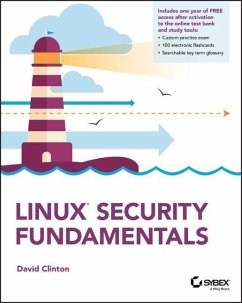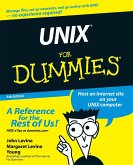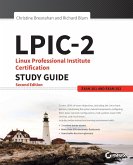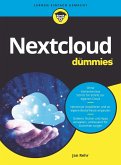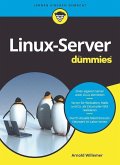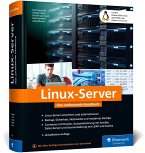David Clinton
Linux Security Fundamentals
David Clinton
Linux Security Fundamentals
- Broschiertes Buch
- Merkliste
- Auf die Merkliste
- Bewerten Bewerten
- Teilen
- Produkt teilen
- Produkterinnerung
- Produkterinnerung
Linux Security Fundamentals provides basic foundational concepts of securing a Linux environment. The focus is the digital self-defense of an individual user. This includes a general understanding of major threats against individual computing systems, networks, services and identity as well as approaches to prevent and mitigate them.This book is useful for anyone considering a career as a Linux administrator or for those administrators who need to learn more about Linux security issues. Topics include:_ Security Concepts_ Encryption_ Node, Device and Storage Security_ Network and Service…mehr
Andere Kunden interessierten sich auch für
![Unix for Dummies Unix for Dummies]() John R. LevineUnix for Dummies23,99 €
John R. LevineUnix for Dummies23,99 €![Lpic-2: Linux Professional Institute Certification Study Guide Lpic-2: Linux Professional Institute Certification Study Guide]() Christine BresnahanLpic-2: Linux Professional Institute Certification Study Guide62,89 €
Christine BresnahanLpic-2: Linux Professional Institute Certification Study Guide62,89 €![Private Cloud mit Nextcloud für Dummies Private Cloud mit Nextcloud für Dummies]() Jan RehrPrivate Cloud mit Nextcloud für Dummies30,00 €
Jan RehrPrivate Cloud mit Nextcloud für Dummies30,00 €![Beginning UNIX Beginning UNIX]() Paul LoveBeginning UNIX34,99 €
Paul LoveBeginning UNIX34,99 €![Linux-Server für Dummies Linux-Server für Dummies]() Arnold WillemerLinux-Server für Dummies28,00 €
Arnold WillemerLinux-Server für Dummies28,00 €![Linux-Server Linux-Server]() Dirk DeimekeLinux-Server69,90 €
Dirk DeimekeLinux-Server69,90 €![FreeBSD Mastery FreeBSD Mastery]() Michael W LucasFreeBSD Mastery24,99 €
Michael W LucasFreeBSD Mastery24,99 €-
-
-
Linux Security Fundamentals provides basic foundational concepts of securing a Linux environment. The focus is the digital self-defense of an individual user. This includes a general understanding of major threats against individual computing systems, networks, services and identity as well as approaches to prevent and mitigate them.This book is useful for anyone considering a career as a Linux administrator or for those administrators who need to learn more about Linux security issues. Topics include:_ Security Concepts_ Encryption_ Node, Device and Storage Security_ Network and Service Security_ Identity and Privacy Readers will also have access to Sybex's superior online interactive learning environment and test bank, including chapter tests, a practice exam, electronic flashcards, a glossary of key terms.
Produktdetails
- Produktdetails
- Verlag: Sybex / Wiley & Sons
- Artikelnr. des Verlages: 1W119781460
- Seitenzahl: 192
- Erscheinungstermin: 10. November 2020
- Englisch
- Abmessung: 233mm x 187mm x 12mm
- Gewicht: 334g
- ISBN-13: 9781119781462
- ISBN-10: 1119781469
- Artikelnr.: 60070517
- Herstellerkennzeichnung
- Libri GmbH
- Europaallee 1
- 36244 Bad Hersfeld
- gpsr@libri.de
- Verlag: Sybex / Wiley & Sons
- Artikelnr. des Verlages: 1W119781460
- Seitenzahl: 192
- Erscheinungstermin: 10. November 2020
- Englisch
- Abmessung: 233mm x 187mm x 12mm
- Gewicht: 334g
- ISBN-13: 9781119781462
- ISBN-10: 1119781469
- Artikelnr.: 60070517
- Herstellerkennzeichnung
- Libri GmbH
- Europaallee 1
- 36244 Bad Hersfeld
- gpsr@libri.de
David Clinton is a Linux server admin and Amazon Web Services solutions architect who has worked with IT infrastructure in both academic and enterprise environments. He has created video courses teaching AWS and Linux administration, server virtualization, and IT security for Pluralsight. He has also written or cowritten a dozen technology books, including AWS Certified Solutions Architect Study Guide: Associate (SAA-C01) Exam, Second Edition, and AWS Certified Cloud Practitioner Study Guide: Foundational (CLF-C01) Exam.
Introduction xiiiChapter 1 Using Digital Resources Responsibly 1Protecting Personal Rights 2Protecting Digital Privacy 4What is Personal Data? 4Where Might My Personal Data Be Hanging Out? 4What Are My Responsibilities as a Site Administrator? 6Can Escaped Genies Be Forced Back into Their Bottles? 6What Can I Do as a User? 7Establishing Authenticity 7Think About the Source 8Be Aware of Common Threat Categories 8Summary 9Back to the Basics 10Review Questions 11Chapter 2 What Are Vulnerabilities and Threats? 15The Basics: What Are We Trying to Accomplish Here? 16What Are Vulnerabilities and Threats? 17What Can Be Exploited? 17Who's Doing the Exploiting? 18Why Do They Attack? 19Common Vulnerabilities 20Software Vulnerabilities 20Hardware Vulnerabilities 21Bioware Vulnerabilities 21Digital Espionage 21USB Devices 21Backdoors 22Wireless Entry Points 22Stolen Credentials 23Data Breaches 23Identity Theft (Besides Breaches) 24Malware 24Network-Based Attacks 25Man-in-the-Middle Attacks 25Denial-of-Service and Distributed Denial-of-Service Attacks 26Network Routing Attacks 26Summary 26Back to the Basics 27Review Questions 28Chapter 3 Controlling Access to Your Assets 33Controlling Physical Access 34Understanding Your Devices 34Protecting Your Devices 36Managing Authentication Through Effective Password Use 38Managing Authorization Through Permissions 44Controlling Network Access 45Firewalls 45Virus and Malware Protection 48Educating Your Users 49Controlling Software Sources 50PC Software Repositories 51Mobile Package Management 51Summary 52Back to the Basics 52Review Questions 54Chapter 4 Controlling Network Connections 59Understanding Network Architecture 60The Transmission Control Protocol 60The Internet Protocol 61Understanding the Domain Name System 64Auditing Networks 65Network Auditing Tools 66Automating Audits 70Securing Networks 71Patch Your Software 71Physically Secure Your Infrastructure 73Secure Your Network Behavior 73Other Stuff 74Summary 74Back to the Basics 75Review Questions 76Chapter 5 Encrypting Your Data at Rest 81What is Encryption? 82Encryption Usage Patterns 85What Should You Encrypt? 85Understanding Hashing vs. Encryption 86What Are Blockchains? 86Encryption Technologies 87Summary 89Back to the Basics 89Review Questions 90Chapter 6 Encrypting Your Moving Data 93Website Encryption 94Why You Should Use Encryption 95How Website Encryption Works 96Generating Certificates 98Email Encryption 99GNU Privacy Guard 100Does Gmail Encrypt Your Emails? 100Working with VPN Connections and Software Repositories 100Securing Your Actions Using VPNs 101Securing Transfers from Software Repositories 104Summary 105Back to the Basics 105Review Questions 106Chapter 7 Risk Assessment 109Conducting Open Source Intelligence Gathering 111Accessing Public Vulnerability Databases 112Vulnerability Data Frameworks 112Vulnerability Data Formats 113Vulnerability Data Metrics 114Vulnerability Data Management Tools 114Conducting Vulnerability Scans 115Conducting Penetration Tests 117Attack Vectors 118Tooling Frameworks 118Follow-Up 119Summary 119Back to the Basics 120Review Questions 121Chapter 8 Configuring System Backups and Monitoring 125Why You Need to Get Backups Right the First Time 127Appreciating the Risks 128Spreading Your Backups Across Multiple Sites 129Testing Your Backups 130Meeting Regulatory Compliance 131Backup Types 132Incremental Backups 132Differential Backups 133Backup Life Cycles 133Multitier Backups 133Multisite Storage Solutions 134Disaster Recovery Planning 134Configuring Monitoring and Alerts 135Working with System Logs 135Intrusion Detection 136Summary 137Back to the Basics 138Review Questions 139Chapter 9 Resource Isolation Design Patterns 143Configuring Network Firewalling 145Balancing Public and Private Networks 145Building Isolated Development Environments 147Working with Sandbox Environments 148Use Cases for Sandboxes 148Sandbox Designs 149Controlling Local System Access 150Configuring Mandatory Access Controls 150Setting Usage Quotas 151Summary 152Back to the Basics 152Review Questions 153Appendix Answers to Review Questions 155Chapter 1: Using Digital Resources Responsibly 156Chapter 2: What are Vulnerabilities and Threats? 157Chapter 3: Controlling Access to Your Assets 158Chapter 4: Controlling Network Connections 160Chapter 5: Encrypting Your Data at Rest 161Chapter 6: Encrypting Your Moving Data 162Chapter 7: Risk Assessment 163Chapter 8: Configuring System Backups and Monitoring 165Chapter 9: Resource Isolation Design Patterns 166Index 167
Introduction xiiiChapter 1 Using Digital Resources Responsibly 1Protecting Personal Rights 2Protecting Digital Privacy 4What is Personal Data? 4Where Might My Personal Data Be Hanging Out? 4What Are My Responsibilities as a Site Administrator? 6Can Escaped Genies Be Forced Back into Their Bottles? 6What Can I Do as a User? 7Establishing Authenticity 7Think About the Source 8Be Aware of Common Threat Categories 8Summary 9Back to the Basics 10Review Questions 11Chapter 2 What Are Vulnerabilities and Threats? 15The Basics: What Are We Trying to Accomplish Here? 16What Are Vulnerabilities and Threats? 17What Can Be Exploited? 17Who's Doing the Exploiting? 18Why Do They Attack? 19Common Vulnerabilities 20Software Vulnerabilities 20Hardware Vulnerabilities 21Bioware Vulnerabilities 21Digital Espionage 21USB Devices 21Backdoors 22Wireless Entry Points 22Stolen Credentials 23Data Breaches 23Identity Theft (Besides Breaches) 24Malware 24Network-Based Attacks 25Man-in-the-Middle Attacks 25Denial-of-Service and Distributed Denial-of-Service Attacks 26Network Routing Attacks 26Summary 26Back to the Basics 27Review Questions 28Chapter 3 Controlling Access to Your Assets 33Controlling Physical Access 34Understanding Your Devices 34Protecting Your Devices 36Managing Authentication Through Effective Password Use 38Managing Authorization Through Permissions 44Controlling Network Access 45Firewalls 45Virus and Malware Protection 48Educating Your Users 49Controlling Software Sources 50PC Software Repositories 51Mobile Package Management 51Summary 52Back to the Basics 52Review Questions 54Chapter 4 Controlling Network Connections 59Understanding Network Architecture 60The Transmission Control Protocol 60The Internet Protocol 61Understanding the Domain Name System 64Auditing Networks 65Network Auditing Tools 66Automating Audits 70Securing Networks 71Patch Your Software 71Physically Secure Your Infrastructure 73Secure Your Network Behavior 73Other Stuff 74Summary 74Back to the Basics 75Review Questions 76Chapter 5 Encrypting Your Data at Rest 81What is Encryption? 82Encryption Usage Patterns 85What Should You Encrypt? 85Understanding Hashing vs. Encryption 86What Are Blockchains? 86Encryption Technologies 87Summary 89Back to the Basics 89Review Questions 90Chapter 6 Encrypting Your Moving Data 93Website Encryption 94Why You Should Use Encryption 95How Website Encryption Works 96Generating Certificates 98Email Encryption 99GNU Privacy Guard 100Does Gmail Encrypt Your Emails? 100Working with VPN Connections and Software Repositories 100Securing Your Actions Using VPNs 101Securing Transfers from Software Repositories 104Summary 105Back to the Basics 105Review Questions 106Chapter 7 Risk Assessment 109Conducting Open Source Intelligence Gathering 111Accessing Public Vulnerability Databases 112Vulnerability Data Frameworks 112Vulnerability Data Formats 113Vulnerability Data Metrics 114Vulnerability Data Management Tools 114Conducting Vulnerability Scans 115Conducting Penetration Tests 117Attack Vectors 118Tooling Frameworks 118Follow-Up 119Summary 119Back to the Basics 120Review Questions 121Chapter 8 Configuring System Backups and Monitoring 125Why You Need to Get Backups Right the First Time 127Appreciating the Risks 128Spreading Your Backups Across Multiple Sites 129Testing Your Backups 130Meeting Regulatory Compliance 131Backup Types 132Incremental Backups 132Differential Backups 133Backup Life Cycles 133Multitier Backups 133Multisite Storage Solutions 134Disaster Recovery Planning 134Configuring Monitoring and Alerts 135Working with System Logs 135Intrusion Detection 136Summary 137Back to the Basics 138Review Questions 139Chapter 9 Resource Isolation Design Patterns 143Configuring Network Firewalling 145Balancing Public and Private Networks 145Building Isolated Development Environments 147Working with Sandbox Environments 148Use Cases for Sandboxes 148Sandbox Designs 149Controlling Local System Access 150Configuring Mandatory Access Controls 150Setting Usage Quotas 151Summary 152Back to the Basics 152Review Questions 153Appendix Answers to Review Questions 155Chapter 1: Using Digital Resources Responsibly 156Chapter 2: What are Vulnerabilities and Threats? 157Chapter 3: Controlling Access to Your Assets 158Chapter 4: Controlling Network Connections 160Chapter 5: Encrypting Your Data at Rest 161Chapter 6: Encrypting Your Moving Data 162Chapter 7: Risk Assessment 163Chapter 8: Configuring System Backups and Monitoring 165Chapter 9: Resource Isolation Design Patterns 166Index 167

